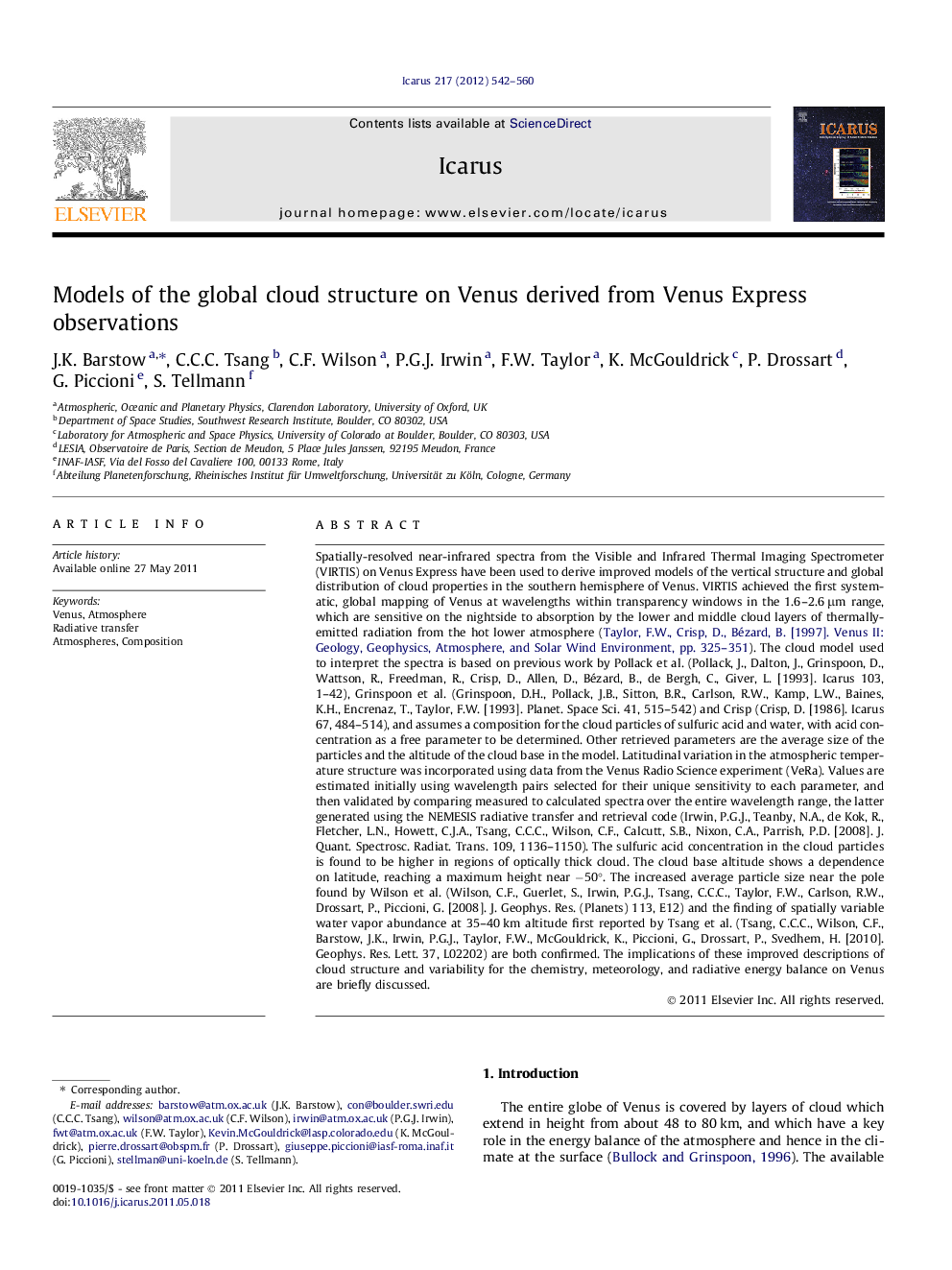| کد مقاله | کد نشریه | سال انتشار | مقاله انگلیسی | نسخه تمام متن |
|---|---|---|---|---|
| 1773681 | 1021143 | 2012 | 19 صفحه PDF | دانلود رایگان |

Spatially-resolved near-infrared spectra from the Visible and Infrared Thermal Imaging Spectrometer (VIRTIS) on Venus Express have been used to derive improved models of the vertical structure and global distribution of cloud properties in the southern hemisphere of Venus. VIRTIS achieved the first systematic, global mapping of Venus at wavelengths within transparency windows in the 1.6–2.6 μm range, which are sensitive on the nightside to absorption by the lower and middle cloud layers of thermally-emitted radiation from the hot lower atmosphere (Taylor, F.W., Crisp, D., Bézard, B. [1997]. Venus II: Geology, Geophysics, Atmosphere, and Solar Wind Environment, pp. 325–351). The cloud model used to interpret the spectra is based on previous work by Pollack et al. (Pollack, J., Dalton, J., Grinspoon, D., Wattson, R., Freedman, R., Crisp, D., Allen, D., Bézard, B., de Bergh, C., Giver, L. [1993]. Icarus 103, 1–42), Grinspoon et al. (Grinspoon, D.H., Pollack, J.B., Sitton, B.R., Carlson, R.W., Kamp, L.W., Baines, K.H., Encrenaz, T., Taylor, F.W. [1993]. Planet. Space Sci. 41, 515–542) and Crisp (Crisp, D. [1986]. Icarus 67, 484–514), and assumes a composition for the cloud particles of sulfuric acid and water, with acid concentration as a free parameter to be determined. Other retrieved parameters are the average size of the particles and the altitude of the cloud base in the model. Latitudinal variation in the atmospheric temperature structure was incorporated using data from the Venus Radio Science experiment (VeRa). Values are estimated initially using wavelength pairs selected for their unique sensitivity to each parameter, and then validated by comparing measured to calculated spectra over the entire wavelength range, the latter generated using the NEMESIS radiative transfer and retrieval code (Irwin, P.G.J., Teanby, N.A., de Kok, R., Fletcher, L.N., Howett, C.J.A., Tsang, C.C.C., Wilson, C.F., Calcutt, S.B., Nixon, C.A., Parrish, P.D. [2008]. J. Quant. Spectrosc. Radiat. Trans. 109, 1136–1150). The sulfuric acid concentration in the cloud particles is found to be higher in regions of optically thick cloud. The cloud base altitude shows a dependence on latitude, reaching a maximum height near −50°. The increased average particle size near the pole found by Wilson et al. (Wilson, C.F., Guerlet, S., Irwin, P.G.J., Tsang, C.C.C., Taylor, F.W., Carlson, R.W., Drossart, P., Piccioni, G. [2008]. J. Geophys. Res. (Planets) 113, E12) and the finding of spatially variable water vapor abundance at35–40 km altitude first reported by Tsang et al. (Tsang, C.C.C., Wilson, C.F., Barstow, J.K., Irwin, P.G.J., Taylor, F.W., McGouldrick, K., Piccioni, G., Drossart, P., Svedhem, H. [2010]. Geophys. Res. Lett. 37, L02202) are both confirmed. The implications of these improved descriptions of cloud structure and variability for the chemistry, meteorology, and radiative energy balance on Venus are briefly discussed.
► Near-IR (1.6 to 2.6 μm) imaging data from Venus Express are used to study global variations in the cloud layers on Venus.
► Parameters retrieved are cloud base altitude, sulfuric acid concentration, and particle size information.
► Significant variability is observed in all of these as a function of total cloud optical depth and latitude.
► The concentration of sulfuric acid in the cloud increases in regions of high optical depth and in the polar collar.
► Implications for chemical, radiative transfer and dynamical models are discussed.
Journal: Icarus - Volume 217, Issue 2, February 2012, Pages 542–560